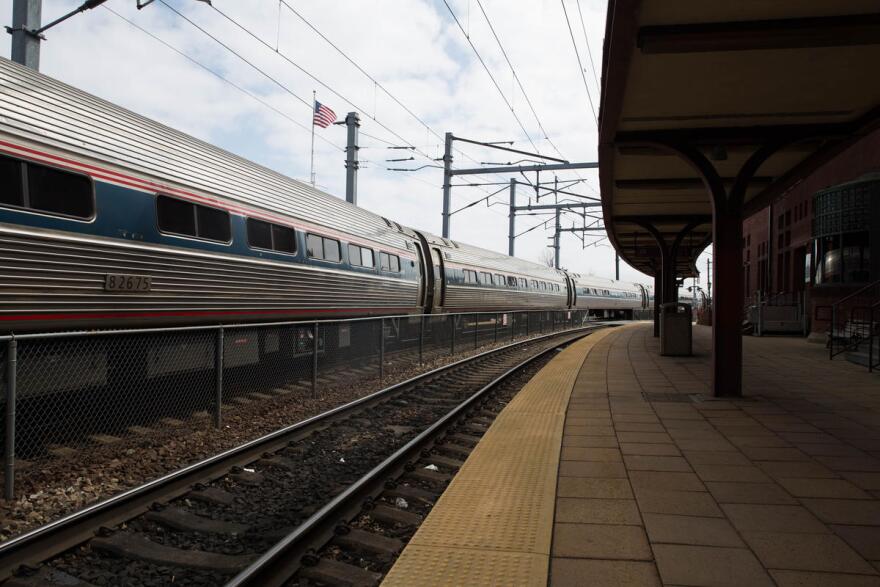Communities along Connecticut’s southeastern shore want faster, reliable train service to D.C, New York and Boston – but not if it skips their local train stations. A proposed federal plan for high speed rail would do just that.
The Northeast Corridor Future Plan would build a bypass cutting through historic parts of Rhode Island and Old Lyme to get around winding coastline rail beds. Some in the port city of New London worry that bypass would decimate their city’s budget and hold back its revitalization.
A small white corner store called Lee’s Oriental Market stands in the shadow of Interstate 95, just north of downtown New London.
Robert Lee bought the store in the 1980s just after a new span of highway bridge was built over the Thames river and through this neighborhood, Historic Hodges Square Village.
“It kinda turned to a ghost town after a while. So, we don’t want that to happen again. We’re revitalizing this neighborhood.”
Lee’s working with the village association to help fix up houses and install bike lanes to draw more students from nearby colleges. Now, he worries that a proposed rail bypass along the highway will hurt investment here.

“Even just having a line drawn in on a map saying that there’s going to be high speed rail, even though it’s going to take 10-20 years to build it, I think that it’ll actually harm this neighborhood ‘cause it’ll actually lower the values of the properties that are along that line.”
Tessie Baker, a customer of Lee’s, says, “That would affect a lot of people, but the end, I think, justifies the means.”
Baker says she likes that the new rail could hit speeds faster than 200 miles an hour.

“I take the train all the time to Virginia, and that’s exciting to me because it would be faster. I don’t really know specifics or anything like that, but anything that’s faster is always better.”
There’s a reason Baker doesn’t know specifics about the high speed rail. Critics say the Federal Railroad Administration failed to inform residents about the bypass that could go through their towns.
“We’re not getting detailed information from the FRA,” says Tim Hanser, with the business improvement district for downtown New London.
Hanser says FRA maps draw the bypass through the city’s only commercial corridor. And any property in this tiny city is important because it’s only about five square miles as it is, and half of that land is not taxable.

The map in front of Hanser also shows a proposed station in Groton, a rural area nearby. So high speed trains would never stop in New London.
“It seems like all this part of the state is being asked to do is to kind of bear the brunt of a construction project with no benefits. I mean we’re really getting no improvement in service, yet we’re losing land, you know, and we’re losing the possibility of people stopping here. So definitely a negative impact.”
Faster travel could still be a positive. The FRA says bypassing New London would save about 30 minutes between New York and Boston. Hanser thinks it could be closer to 15 minutes. If that’s the case, he’s not sure it’s worth the cost.
“Just this bypass is $10 to 15 billion. So you’re talking about a billion dollars a minute.”
Comparatively, Hanser says upgrading tracks and fixing rail bridges could help trains run faster and it would drop people near the growing number of cafes and shops near New London’s downtown Union Station.

Matt Roy stands on the train platform. He lives in New York City and takes Amtrak more than two-and-a-half hours to visit family in northeastern Connecticut.
“The only thing that really makes the commute difficult, besides the slow speed, is the reliability of the trains sometimes. Uh twice, I’ve been on trains where the engines have failed and we’ve had to sit there and wait, get pulled back into the station in New Haven.”
Roy thinks it’s most important to invest in reliable train service. And he’s not alone.
Just up the road from the train station, New London Mayor Michael Passero preps for a budget meeting at City Hall. Passero says the high speed rail bypass raises concerns about future budgets. Now, he worries the federal government could seize precious property for the high speed rail line.
“This is going to really suppress economic development, if people are looking 20 or 30 years down the line and looking at a whole section of New London and believing that that’s going to end up taken by eminent domain.”

The city is home to Kelo v. New London one of the biggest eminent domain cases in history that went all the way to the Supreme Court in 2005. New London condemned people’s homes for an economic development project that never came to be. This time, Passero hopes the FRA will come up with a plan to benefit New London’s downtown station.
“Our elected officials really have to work hard to overcome the obstacles to do that for us, but it’s time. New London’s got a future, the train station’s important to it.”
The official blueprint for the future of rail in the Northeast Corridor will be outlined in the FRA’s Record of Decision. Bryan Rodda with the FRA announced at a regional planning meeting on the other end of the state that the decision isn’t set in stone.
“The actual selection in the record of decision is really going to be focused on the vision of where we would like to go. But there’s still many constraints, such as funding constraints, and just having actual funding available.”
Rodda says the FRA is talking with states and is considering more than 8,000 public comments that have poured in since the initial proposal in December 2016. Most comments show people prioritizing improvements on existing railroads.
This report is the second in a two-part series about possible federal rail plans in New England. The first is "With Federal Decision Nearing, Southern New England Towns Push Back Against Rail Plan."
This report comes from the New England News Collaborative, eight public media companies coming together to tell the story of a changing region, with support from the Corporation for Public Broadcasting.

